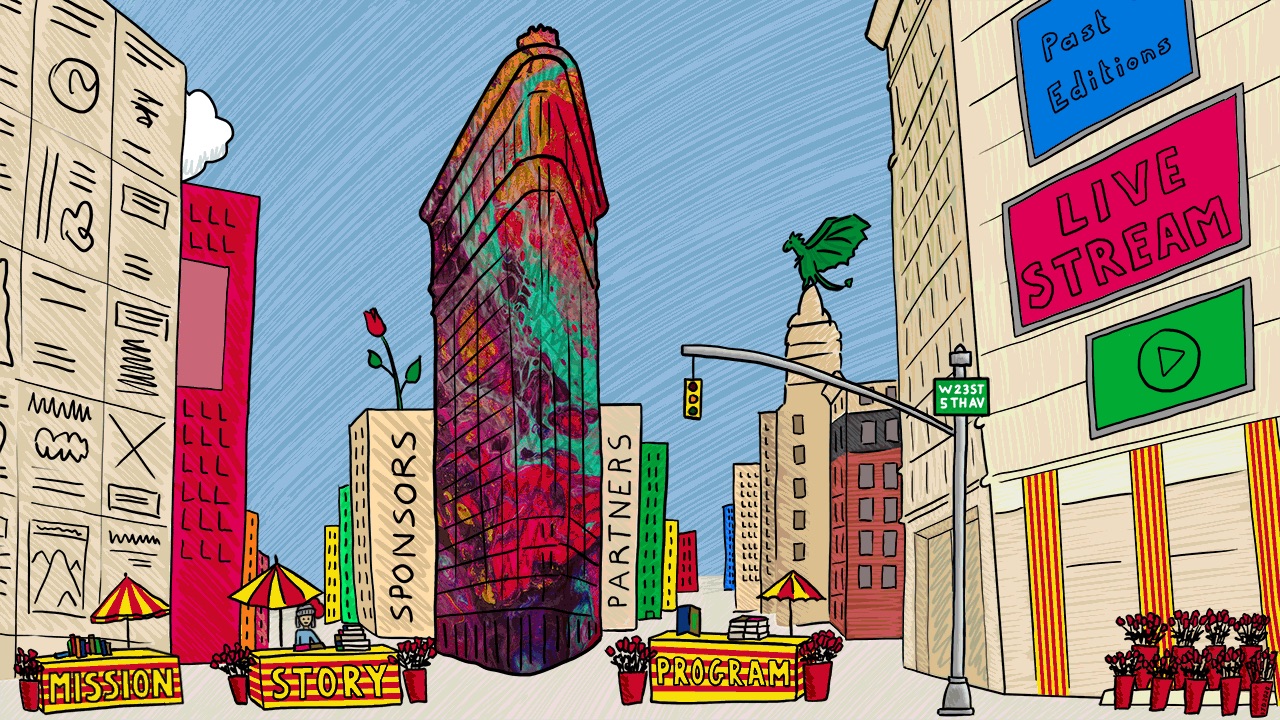 Illustration, Isabelle Duverger
Illustration, Isabelle Duverger
New York City may not seem to have a strong Catalan connection, but the culture is sustained by the Farragut Fund for Catalan Culture which has been running the state-side version of the Sant Jordi Book Festival, in imitation of the beautiful Barcelona fair, for the last six years. (On a side note, part of the initial design of Roosevelt Island was designed by Catalan architect Josep Lluís Sert).
Sant Jordi’s Day is a major Catalan holiday that celebrates Saint George, who slayed a dragon to save the king’s daughter. Saint George, the patron saint of the former Crown of Aragon, stabbed the dragon in its cave with his sword, and from the drops of blood that fell from the dragon’s wing, a rose bush sprang up. For centuries, on this day, Catalan gentlemen would give their beloved a rose. In the 1920s the Catalan booksellers’ association added books into the mix and the Sant Jordi Book Festival was born. Today, La Diada de Sant Jordi, also known as the Day of the Rose or the Day of the Book, functions very similar to Valentine’s Day in the United States. As Mary Ann Newman, founding director of the Farragut Fund for Catalan Culture in the U.S. writes, “No longer gender-based, lovers, friends, and family now give one another books and roses. Valentine’s Day—for nerds.”
In Barcelona, thousands of rose stands and bookstalls line the streets on April 23 to honor the heroic actions of Sant Jordi. Around 10 percent of Catalonia’s revenue stems just from sales on Sant Jordi’s Day. This year, Sant Jordi’s Day will be much different, as COVID-19 cases continue to rise in Spain, which has the second most number of cases. Yet, in New York City this year, Sant Jordi’s Day would have been celebrated with lit crawls in DUMBO and Chelsea, with book stands and flower stalls in Madison Square, and with live concerts and guest authors. However, The Farragut Fund for Catalan Culture in the United States has moved Sant Jordi in New York online, extending the one day celebration to three days from April 23-25.

Graphic design, Xavier Clavijo; Illustration, Isabelle Duverger
“Knights and dragons and books and roses! How could a virus take us down?” writes Newman, “An online portal through which people can enter and choose an area of activity following different narratives, the site will be innovative and interactive, incorporating live streaming of panel discussions, web-based AR experience, video mapping, and the history of Sant Jordi as an immersive journey with augmented reality experiences that are accessed through a web browser rather than an app.”
This year, Sant Jordi in New York will function as an online festival “where viewers can step from a Parisian café into an Icelandic hot pot or a Mediterranean souk.” In keeping with the festival’s tradition, numerous Catalan authors will be discussing their works such as essayist Marta Marín-Dòmine, author Jordi Nopca, and writer and soccer enthusiast Jordi Puntí.
 Illustration, Isabelle Duverger
Illustration, Isabelle Duverger
In celebration of world literature, authors, translators, and musicians will be talking about (and in some cases performing) their new works in languages from Galician to Swahili. Joining the cast of authors is renowned French-Lebanese writer Amin Maalouf, Iraqi author Rodaan Al-Galidi, and Icelandic writer Bergur Ebbi. A number of translators of these world authors like Sophie Hughes and Tess Lewis, as well as critics like Maya Jaggi will be speaking about their projects. The event is produced by Ignacio Garcia-Bustelo and a full list of participants can be found on the Sant Jordi in New York website.
While browsing through author talks, explore the art of video artists and animators Laia Cabrera and Isabelle Duverger, who created a cityscape based on Madison Square, depicting the Flatiron Building as an open book. Three-dimensional dragons will chase user generated books and roses on the website thanks to designer Aniol Saurina Masó.
Check out the programming and forthcoming livestream on the Sant Jordi NYC website. The event is also fundraising through a Kickstarter page in order to offer stipends to the writers, translators, and musicians involved in the programming as well as to support bookstores and publishers throughout these socially distanced times.






